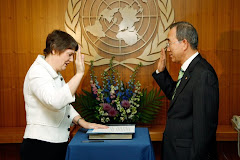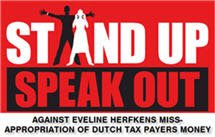 It has come to GAP's attention
that lawyers from the United Nations have questioned statistics that we
compiled regarding the record of the UN Ethics Office, which is charged
with reviewing retaliation complaints and safeguarding the interests of
UN whistleblowers. Specifically, in the Respondent’s Reply in UN Dispute Tribunal case GVA/2011/090, the UN claimed that GAP’s statistic was “entirely incorrect and unfounded.”
It has come to GAP's attention
that lawyers from the United Nations have questioned statistics that we
compiled regarding the record of the UN Ethics Office, which is charged
with reviewing retaliation complaints and safeguarding the interests of
UN whistleblowers. Specifically, in the Respondent’s Reply in UN Dispute Tribunal case GVA/2011/090, the UN claimed that GAP’s statistic was “entirely incorrect and unfounded.”GAP takes such accusations seriously. As soon as we became aware of the UN’s critique, we double-checked our numbers and issued an official response, which first appeared on the UNJustice website and can be read below. We hope that these clarifications will help whistleblowers who currently have cases pending before the UN internal justice system.
Dear UN Justice,
Thank you for contacting the Government
Accountability Project (GAP) and for giving us a chance to reply to the
statement made by the UN’s lawyers regarding the record of the UN Ethics
Office (in paragraphs 20-23 of the Respondent’s Reply in Walter Gehr v. Secretary-General of the United Nations). We appreciate the opportunity to double check our numbers and clarify the discrepancies.
Let me explain how GAP arrived at these
statistics and where the discrepancies between our numbers and the UN
lawyers’ lie. In our initial blog
on this issue (which has since been revised) we stated that “According
to Ethics Office reports to the Secretary-General, from August 1, 2007
to July 31, 2010, a prima facie case of retaliation was found in
1.5% of the requests for protection from retaliation received by the
Office (2 of 134 cases).” This was before we located the 2006, 2007 or
2011 Ethics Office reports, so it only uses statistics from the 2008,
2009 and 2010 reports. Our analysis was limited to those reports because
they were the only ones that we were able to locate at that time (we’ve
since located all of them and have started quoting a new statistic incorporating every annual report).
Here is how we arrived at our initial numbers mentioned in the Respondent’s Reply:
According to paragraphs 48 of the 2008 report, “From 1 August 2007 to 31 July 2008, the Ethics Office received 45 complaints of retaliation” and found 0 prima
facie cases. According to paragraph 52 of that report, the two prima
facie cases from 2007 were not substantiated by OIOS, so retaliation was
ultimately not found. We did not count those two cases, as the
prima facie determination was made during a previous reporting cycle
(the 2007 report, which we had not yet located) and would have been
counted in the 2007 report.
According to paragraph 60 of the 2009 report, 64 requests were received. Paragraph 62 says that 0 prima facie cases were found, but paragraph 65 says that one was found from the cases left over from the previous cycle.
According to paragraph 33 of the 2010 report, “from 1 August 2009 to 31 July 2010, the Ethics Office received 36 requests related to protection against retaliation.” According to paragraph 35, it found 0 prima facie case in these new cases, but according to paragraph 37 it found one prima facie case from the leftover cases from the previous cycle.”
GAP unfortunately did make an error, as
there were 145 requests for protection against retaliation during this
time, not 134. We would like to apologize to Mr. Gehr and other
whistleblowers for this mistake. But, the mistake was ironically in the
Ethics Office’s favor. So, the number should be 2 prima facie cases out
of 145 complaints of retaliation, which is an even worse record for the
Ethics Office (1.4%). This number has been corrected on our website
(although for GAP’s 2012 blog entries, we use a new statistic that
incorporates all annual Ethics Office reports).
Now, in paragraph 22 the UN lawyers
distort this statistic because for some reason they decided to add 2011,
even though that was clearly not included in GAP’s statistic. So they
added another 55 cases (see para. 26 of the 2011 Ethics Office
report) and made it seem like those should have been included in GAP’s
statistic, even though ours focused on a different time period as we had
not yet located the relevant report. We believe that the reason that
they included the 2011 report was because in that year, the Ethics
Office found 3 prima facie cases of retaliation (1 in para. 26
and 2 in para.28), so they can now claim in paragraph 23 of the reply
that they have found 5 prima facie cases.
Since GAP now has all of the Ethics Office
reports, we have recently added in the 2006, 2007 and 2011 numbers and
have started using this broader statistic in our correspondence.
According to paragraph 54 of the 2007 report, the Ethics Office received
52 complaints of retaliation and found 2 prima facie cases of retaliation. According to paragraph 45 of the 2006 report, the Ethics Office received 45 complaints of retaliation and found 1 prima facie case. If you add in the 2011 numbers and our previous statistic, this brings the total number of complaints to 297 and the total number of prima facie cases to 8 or approximately 2.7% of retaliation complaints.
GAP’s numbers are based on retaliation
complaints received. We did not subtract those cases that were
withdrawn, involved advice or were outside the mandate of the Office.
One reason for this is because we have been informed by some
whistleblowers that the Ethics Office advised them to drop their cases,
so we think that those numbers should be included in the overall
statistic. Another reason is that there has been some confusion over the
years regarding what the actual mandate of the UN Ethics Office is. For
example, in 2007 the Ethics Office considered some cases from the funds
and programmes, which it no longer does (provided that those funds have
an Ethics Office). Finally, we wanted to have an overall picture of how
many complaints the Ethics Office receives and how many of those
inquiries ultimately result in a whistleblower receiving relief.
The really interesting thing to look at is
what happened to those 8 prima facie cases. After all, a prima facie
decision is meaningless if retaliation is not ultimately substantiated
after the OIOS investigation and the whistleblower is not protected.
Some of the reports clearly say that certain cases weren’t
substantiated, though some are a little vaguer. Only once does a
report say that retaliation was ultimately substantiated and that the
Office “issued recommendations pertaining to disciplinary actions and
corrective measures to the Executive Office of the Secretary-General and
the Department of Management, pursuant to ST/SGB/2005/21.” (see
paragraph 31 of the 2011 report). So, it appears that of the 297
requests related to protection against retaliation received by the
Ethics Office since its launch in 2006, only one resulted in the Ethics Office ultimately substantiating retaliation and recommending relief. But even that one whistleblower has not yet been completely protected from retaliation.
Please let us know if you have any additional questions or would like any clarifications.
To be fair, we should also mention that in 2011, under a new
director, the record of the Ethics Office has improved, as there were
three prima facie findings that year and one case that was ultimately
substantiated (versus five prima facie cases total from 2006-2010, with
apparently no ultimate findings of retaliation). Also, the Ethics Office
has informed us that some of the dismissed cases were not whistleblower
cases (i.e. claims in which the staff member was not a whistleblower
and merely wanted to contest a performance review). They also include
cases in which someone requested advice regarding the protection against
retaliation policy, but did not submit a complaint. Nevertheless, GAP remains extremely concerned that apparently no whistleblower at the UN has been fully protected from retaliation since the Ethics Office was established. It is our hope that in the future, rather than wasting its energy on nitpicking our numbers, the UN will instead take action to actually address the problem by protecting credible whistleblowers.
If you have any questions about these statistics or would like more information, please email shelleyw@whistleblower.org.
Shelley Walden is International Officer for the Government Accountability Project, the nation's leading whistleblower protection and advocacy organization.
















































No comments:
Post a Comment